There’s something special about antique and vintage sewing machines. They’re no longer just functional tools, but hold a beautiful piece of history. Sewing machines have certainly progressed since their invention in the early 1800s…
Sewing machines produced before the 1900s are antique, while those produced from 1900 to 1970 are vintage. Singer, Bernina, Pfaff, and Kenmore are synonymous with quality sewing machines. Antique and vintage sewing machines are categorized into straight stitch, zig-zag, and treadle machines.
Below we will explore the best antique and vintage sewing machines on the market.
We will look at the features that make these machines unique and why you might consider adding one to your growing collection of vintage sewing machines.
We will also look at best practices for the maintenance of your antique sewing machine – so it may last for many more generations to come.
- What Are The Most Popular Vintage & Antique Sewing Machines?
- 1. Singer 201
- 2. Singer Featherweight
- 3. Kenmore Vintage Sewing Machine
- 4. Bel-Air 740 DeLuxe
- 5. Bernina 730 Vintage Sewing Machine
- 6. Pfaff 130 Sewing Machine
- Why Should You Own An Antique Or Vintage Sewing Machine?
- 1. Sewing Machine Parts Were Built To Last
- 2. Antique And Vintage Sewing Machines Are Easier To Repair
- 3. Straight Stitches Are Easy
- 4. Some of the Older Machines Are More Versatile
- 5. Reliably Made Machines That Look Beautiful
- Our Thoughts on Older Sewing Machines
What Are The Most Popular Vintage & Antique Sewing Machines?
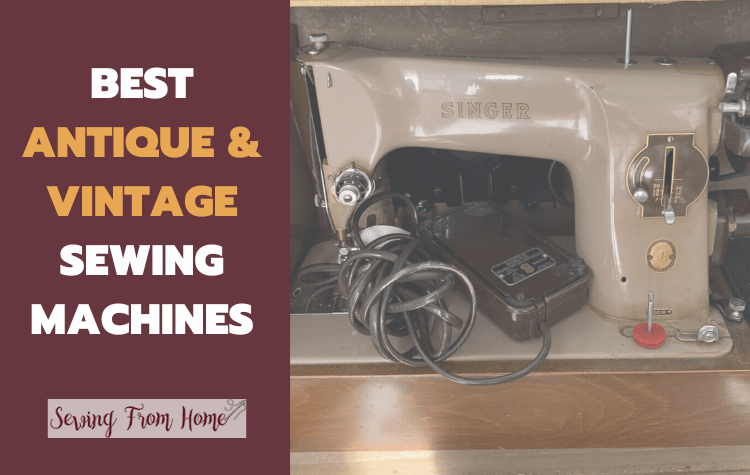
Let us clarify if you are having trouble distinguishing between an antique sewing machine and a vintage.
The most valuable antique and vintage sewing machine is the Singer model 301. It was first introduced in 1932 and was the first sewing machine to offer a built-in motor.
According to sewing machines specialists and collectors, machines produced before 1900 are “antique,” while those produced between 1900 and 1970 are referred to as “vintage.”
Here are some of our favourites:
1. Singer 201
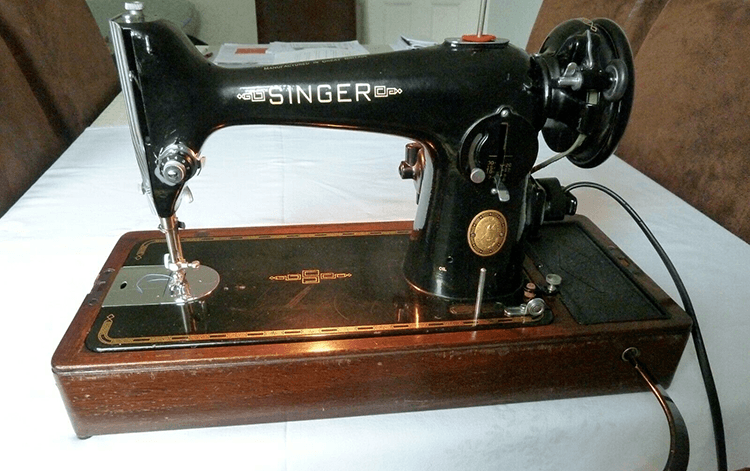
Singer machines introduced the first commercially viable machine in 1850, built by actor, inventor, and entrepreneur Isaac Singer. After many tries and misses, Isaac Singer perfected the design, so the Singer 201 was born in 1935.
When the Singer 201 was first introduced, it was only a straight stitch machine, but Singer included attachments for other stitches like attachments for zig-zag stitch, blind stitch, and a buttonhole attachment.
As far as sewing machines go, we know them to be noisy; however, strangely enough, for a machine of this size, the Singer 201 was quieter than other machines around at the time. And unlike other sewing machines, they didn’t wobble when in use!
Amongst sewing connoisseurs, the Singer 201 is considered top of the range and a collector’s item. It was a sturdy cast iron machine with gears and a built-in motor that first sold for around $6!
2. Singer Featherweight
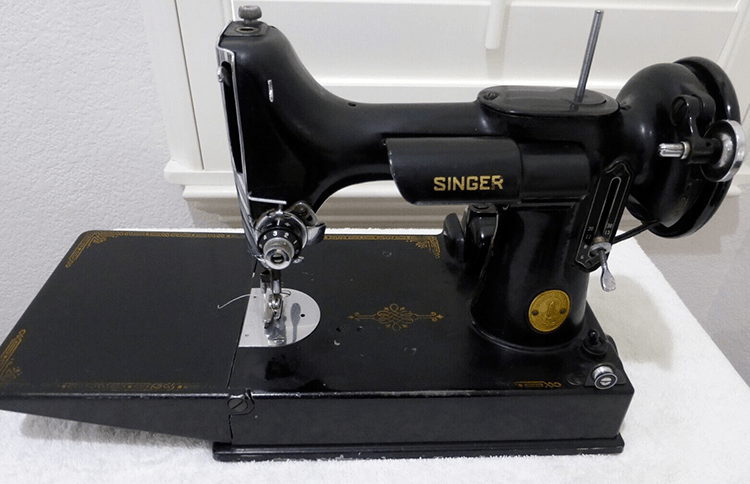
Another vintage machine from the Singer range is the Singer Featherweight. As the name suggests, this machine is lighter than other sewing machines produced around the same time, including other models of Singer machines.
The Featherweight sewing machine with its aluminum frame was durable and came in a wooden carry case. Like other Singer sewing machines, the Featherweight was a straight stitch machine.
This grand old lady is still a firm favorite amongst quilters who flock to this model because of its ability to stitch through multiple layers of fabric.
Besides the quilters, many collectors are out looking for this model because of its durability and sturdiness. These models are rare, so be prepared to pay a little extra than the usual cost of sewing machines.
3. Kenmore Vintage Sewing Machine
The Kenmore range of sewing machines was initially produced for Sears Roebuck and built by Janome and Whites in the 1960s. The early machines were constructed of cast iron and built to last!
The Kenmore machines were tough enough to sew any fabric type, including leather, vinyl, or multiple fabric layers when quilting. They were known as budget machines priced at $6.75 for the early treadle models.
The Sears Kenmore was popular because it was easy to thread with easily adjustable knobs for stitch length and width. Despite the weight and size, this machine remains one of the best vintage sewing machines.
4. Bel-Air 740 DeLuxe
The Bel-air range is a Japanese brand of sewing machines. However, the manufacturers initially cloned from Singer sewing machines. For this reason, the Bel-air Deluxe, although classified as a vintage machine, is not regarded as one by seasoned sewing machine collectors.
Many machines of this type were produced at that time, and because they were Singer clones, these factors lowered the value of this machine.
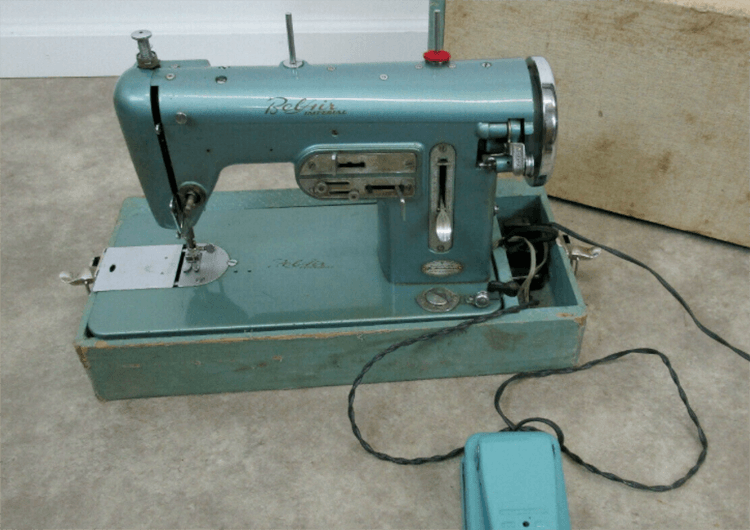
However, if you want to use your antique or vintage machine for quilts, duvets, or hard-wearing jeans, then this is the machine we suggest you get. This machine has all the features and a range of stitches of a modern-day sewing machine but is more durable and versatile.
Many modern sewing machines are now computerized. And with technology changing daily, as unlikely as it may seem, we can count on a machine like the Bel-air Deluxe because it runs on a gear system that outshines some of the fanciest modern machines.
5. Bernina 730 Vintage Sewing Machine
Bernina International began as a hemstitching machine patented by Swiss mechanic Karl Friedrich Gegauf in 1893.
However, it was only around 1932, when his sons, Fritz and Gustav Gegauf, took over the business following Karl’s death, that the brothers’ first household sewing machine was built.
Around 1937, Fritz introduced the Bernina zig zag sewing machine. The sewing machines were built for household and upholstery use having only a straight stitch. Following these inventions and moving towards modernization, Fritz’s daughter Odette Ueltschi took over the company in 1963 and introduced the knee press in the Bernina 730.
This changed the course of many sewing machines to come.
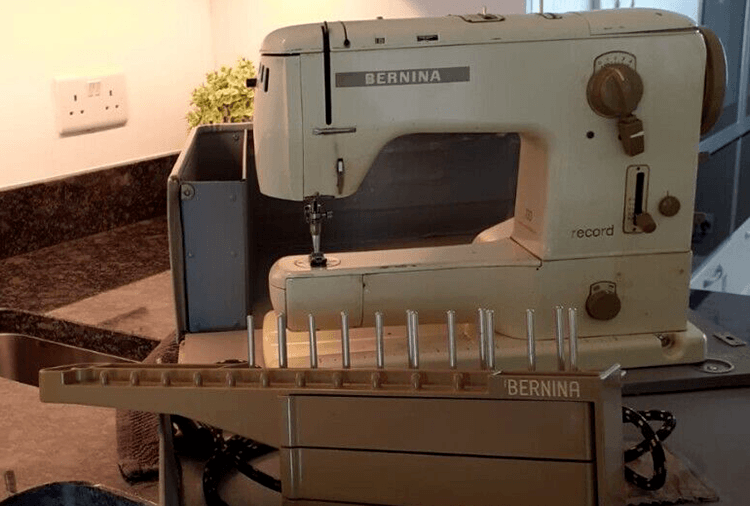
The Bernina 730, with its sturdy outer shell, is durable and has approximately twenty decorative stitches. You can also change the zig-zag stitch width to a maximum width of 4mm, a rare feature amongst sewing machines of that time.
However, the Bernina 730 was not equipped to handle stretch stitches. This feature came much later to other Bernina models.
Made with Swiss precision, the Bernina 730 remains a much sought-after item by sewing enthusiasts and machine collectors.
6. Pfaff 130 Sewing Machine
If there is any sewing machine that takes the crown of vintage sewing machines, it has to be Pfaff.
The Pfaff brand has been around for 150 years; it stands out as it is widely known for its durability and quality. Therefore Pfaff machines are not just collectors’ items but also sought after for their excellence and quality workmanship.
Pfaff, a German brand founded around the mid-1800s by George Pfaff, is now owned by Husqvarna Vikings. The Pfaff 130, a true vintage sewing machine, whose parts were constructed from heavy metal, and as such, they required a cleaning instead of having to call in a mechanic for repairs.
The Pfaff 130 is a heavy-duty zig-zag sewing machine and is best suited for use on multiple layers of fabrics of any weight and thickness.
Of all vintage sewing machines, Pfaff is the one machine that you could fetch a fair price for. It is a highly collectible machine, and a Pfaff 130 in good condition sells for around $400, which is more than other vintage sewing machines fetch!
Why Should You Own An Antique Or Vintage Sewing Machine?
If you have to ask the experts, they will tell you a vintage or antique sewing machine is not worth much monetarily. And there are many reasons for them not being as valuable as an antique car or watch.
But many die-hard sewing fans swear by vintage sewing machines, for a few good reasons:
1. Sewing Machine Parts Were Built To Last
Most sewing machines of that era were made of cast iron. The gears, foot pedals, etc., were constructed of metal.
As a result, the sewing machine parts were built to last.
They did not break down easily, unlike our modern sewing machines, which are generally built of plastic and not as durable.
2. Antique And Vintage Sewing Machines Are Easier To Repair
There wasn’t much to antique and vintage sewing machines.
They were easy to thread, did not have too many stitches, and sewing was easy. Therefore if you have an antique or vintage sewing machine, you could repair them yourself.
And with the internet at our fingers, it is now easier to find spare parts for your beloved sewing machine.
3. Straight Stitches Are Easy
Our modern-day sewing, with its many decorative stitches, hampers sewing in a straight line.
You will not have this issue with an antique or vintage sewing machine. And this is because of the needle position and the feed dog mechanism, which you adjust to accommodate decorative stitches.
4. Some of the Older Machines Are More Versatile
So much is involved with our new computerized sewing machines, especially if you change from one fabric type to another. And certain fabrics are avoided altogether.
However, this is hardly the case with antique or vintage sewing machines. They were built to handle any fabric type, of any thickness.
5. Reliably Made Machines That Look Beautiful
These sewing machines of the past had intricate and beautiful metal and woodwork. Vintage and antique machines were constructed of heavy cast iron with wooden casings or extendable tables.
Once these machines are set down, they are not meant to be moved around! The weight and sturdiness of these antiques make them much sought-after items for collectors and amongst fashion and sewing enthusiasts.
Our Thoughts on Older Sewing Machines
There are many great antique sewing machines, and it can be tough to choose just one.
But if you’re searching for the best of the best, the machines in our list have a rich and celebrated history. From Singer to Bernina, each has its unique story and features that make it an excellent choice for those looking for an antique or vintage sewing machine.
What’s your favorite?
